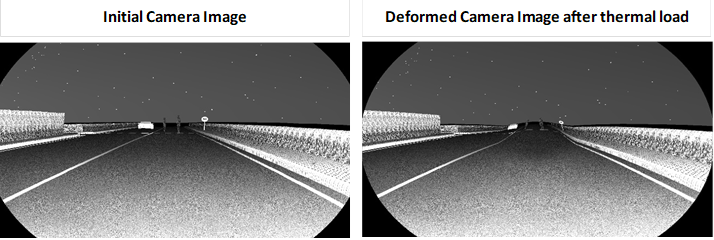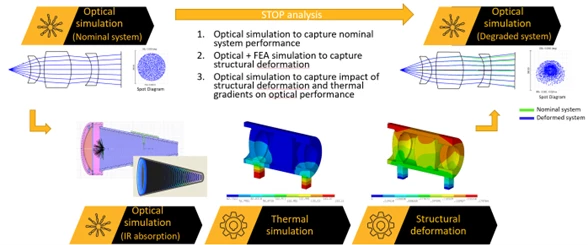As humans become more reliant on technology, machine vision becomes an increasingly critical component. Many systems today rely on machine vision systems, including package tracking, security scanners, autonomous vehicles, and even some smart phone applications.
As with many optical systems, these machine vision cameras can be subject to environmental conditions. To illustrate this, we look at a single example of an automotive HUD system that has an Inferred camera to enhance the machine or drivers’ perception of animals and pedestrians. The image glow demonstrates how the image captured by the camera can be affected by extreme thermal loads which could be placed on the system during a drive on a hot summer day. This could pose a problem, as the system may not correctly identify a hazard, potentially resulting in human injury.

To tackle this challenge, optical designers and engineers undertake a process known structural thermal optical performance (STOP) analysis. Consider how a temperature change may cause some thermal displacement of the optics themselves. This could then displace the optomechanical housing, which could in turn place stress on the optics which further displaces them. Additionally, the change in temperature causes a change in the index of refraction of the optical elements. When combined, all these factors can lead to degradation of the image.

The OpticStudio STAR module enables robust STOP analysis by allowing the user to easily incorporate Finite Element Analysis (FEA) data into OpticStudio. This allows the engineer to simulate the environmental effects of structural and thermal loads on their optomechanical system and how that impacts the optical performance. It also helps reduce the number of iterations for prototyping and testing, which can lead to cost savings. OpticStudio also works well with some of the other Ansys tools, including Ansys Mechanical and Ansys Speos, which were used to create some of the above images.
Author: Steven LaCava / Senior Application Engineer


